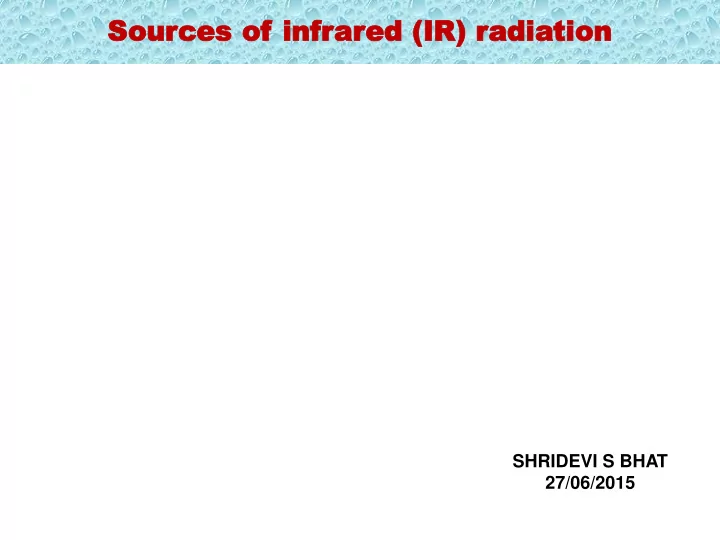

So Sour urce ces s of of in infr frar ared ed (IR) r (IR) rad adia iatio tion SHRIDEVI S BHAT 27/06/2015
Intr Introd oduc uction tion Classification of electromagnetic radiation and IR radiation:
Histo History 1800 – William Herschel discovered the IR radiation 1859 – Gustav Kirchhoff derived the law of thermal radiation 1893 – Wilhelm Wein derived the displacement law 1897 – Walter Nernst invented Nernst glower 1901 – Max Planck derived Planck's law
Blac Black k body body radia adiator tors A perfect absorber for all incident radiations and also an ideal emitter Ideal source for thermal radiation Planck’s law: I – intensity of corresponding wavelength at given T h – Planck’s constant c – speed of light λ – wavelength k – Boltzmann’s constant
Wein’s displacement law: Stefan’s law: P = σ T 4 The thermal radiation spontaneously emitted by many ordinary objects can be approximated as blackbody radiation Examples for black body radiators are the sun and other stars, incandescent lamps, human beings and other animals etc.
Human beings emit IR radiation with λ max = 9.3 µm Applications: Temperature measurement Infrared cameras Automatic light switches Anti-intruder devices
Ner Nerns nst t glo lower er It was used to provide continuous source of IR radiation for use in spectroscopy A cylindrical rod or tube composed of a mixture of certain oxides such as zirconium oxide (ZrO 2 ), yttrium oxide (Y 2 O 3 ) and erbium oxide (Er 2 O 3 ) at a ratio of 90:7:3 by weight. Pt leads at the ends of the cylinder permit the passage of electricity Operates at wavelength range of 2 to 4 microns Has a large negative temperature coefficient of electrical resistance and preheating to about 2000 o C was necessary
Globa Globar Used as thermal light source for infrared spectroscopy It is a silicon carbide rod of 5 to 10 mm width and 20 to 50 mm length which is electrically heated up to 1000 to 1650 ° C When combined with a downstream variable interference filter, it emits radiation from 4 to 15 micrometres wavelength
Qua Quartz tz tun tungs gsten ten Haloge Halogen n (Q (QTH) TH) lamps lamps It is a popular near infrared (NIR) source These use a doped tungsten filaments inside a quartz envelope filled with rare gas and a small amount of halogen Current flowing through the filament heats tungsten to around 3000 K The combination of the halogen gas and the tungsten filament produces a halogen cycle chemical reaction which redeposit evaporated tungsten back onto the filament, increasing its life and maintaining the clarity of the envelope
IR l IR las aser ers IR lasers of different wavelengths like 850 nm, 1300 nm, 1310 nm, 1550 nm and 1625 nm are available CO 2 laser is used in IR spectroscopy for far IR measurements Made up of a discharge tube consisting primarily of CO 2 , N 2 , H 2 and/or xenon and He produces a beam of infrared light with the principal wavelength bands centering around 9.4 and 10.6 micrometers
Recommend
More recommend